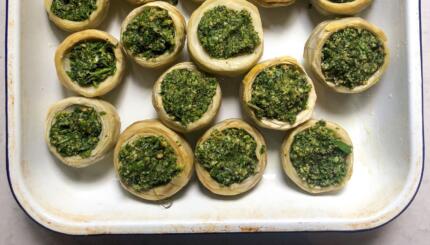Over two and a half millennia ago, the People of Israel already harbored a deep enmity towards the People of Moab. The Book of Numbers (chapter 25) implicates the women of Moab in seducing the Israelite men to sexual sin and to idolatry, transgressions for which God struck down 24,000 Israelites. Later in the Book of Deuteronomy (chapter 23), the Moabites are singled out for hiring the soothsayer Bilaam to curse the Israelites. Furthermore, the Moabites are accused of not greeting the Israelites with food and water when the latter were on their arduous journey after having left Egypt. For these two egregious violations of the moral code, all future generations of the People of Israel are commanded never to take any steps to advance the welfare of or to benefit the People of Moab. Furthermore, no Moabite shall ever be permitted to enter the congregation of the Lord through marriage to a member of the People of Israel.
This legacy of hostility between the two peoples spills over beyond the Torah (Pentateuch). During part of the era described in the Book of Judges, the Israelites and the Moabites are locked in open warfare (Judges chapter 3).
The Book of Ruth, read in synagogues during the holiday of Shavuot, situates itself at the time of the Judges, and according to some rabbinic opinions, its events take place exactly during these times of bellicosity (Midrash Seder Olam Raba 12; Midrash Ruth Raba 1:1).
Elimelech with his wife Naomi and their two sons, who left Bethlehem at a time of famine and settled in Moab, are punished by God for seeking succor in the land of the enemy. Elimelech dies prematurely, and his sons – who add insult to injury and marry Moabite women – are struck down by God as well (Ruth 1:1-5; Midrash Ruth Raba 2:9). Naomi left bereft and distraught, turns to her daughters-in-law, and exclaims that “The Lord has struck out against me,” after employing a phrase whose simple meaning is “I am embittered because of you” (Ruth 1:13). Although several verses make it clear that there are warm feelings between Naomi and her deceased sons’ wives, they are, after all, Moabites.
One of the Moabite daughters-in-law, Ruth, accompanies Naomi back to Bethlehem. There she is warned more than once about the dangerous situation in which she is putting herself, lest she be molested by locals who would prefer not to have her in their midst (Ruth 2: 9, 22). She refers to herself as a foreigner and braces herself for callous treatment from the residents of Bethlehem (Ruth 2:10). Later on in the story, a potential husband recoils in disgust at the very thought of bringing a Moabite girl into his household, lest “I destroy my own inheritance” (Ruth 4:6; Midrash Ruth Raba 7:7).
And yet amazingly, by the end of the story, Ruth is married into an upstanding Israelite family (Ruth 4:13). She gives birth to a child who according to the closing chapters of the book is to become the grandfather of none other than the illustrious King David himself (Ruth 4:17-22). According to biblical writings, from King David springs forth the line of the future Messiah, who will redeem both the Jewish People and the world at large (Isaiah 11)!
How and why does it happen that redemption begins with a lowly Moabite woman’s entrance into the Jewish People? What lesson are we being asked to learn?
The answer is found in the heart and in the deeds of one Bethlehemite who had the courage to be different, to break the mold. Boaz the son of Salmon was his name, a well-to-do middle-aged landowner. He alone takes note of the poor, despised Moabite widow, and does something about it (Babylonian Talmud Tractate Shabbat page 113b). He welcomes her to glean in his field. He defends her from those who would do her harm. He offers her food and drink, and they sit and eat together. During the meal, he speaks kindly to her and praises her fidelity to her mother-in-law. Afterward, he tells his field hands to purposely leave behind some sheaves so that her gleaning will provide an adequate amount of food to bring home. At his behest, throughout the barley and the wheat harvest, she gleans only in his fields (Ruth 2:4-16). Ruth is uplifted, saved from humiliation, and she and Naomi are rescued from starvation.
This is how and this is where redemption begins.
Boaz was somehow able to see an individual human being created in God’s image where others saw just the undifferentiated, dark, grey mass of the enemy. He was somehow able to overcome centuries of animosity, stereotypes, prejudice, and taboos and to simply appreciate and connect to the hunger, the pain, and the goodness of a lonely alienated and despised stranger. He had the courage to be kind where others were cruel.
According to rabbinic lore, Boaz was able to muster the courage to be different because he trusted in God. He opened himself up, allowing God to place in his heart a blessing for Ruth rather than a curse. Social and religious norms were subverted by God’s righteousness working through him (Midrash Ruth Raba 6:1). If you will, he acted prophetically. He did the right thing while all those around him were telling him that it was the wrong thing. He was able to feel and to implement the full import of the Torah’s commands not to vex the stranger and to behave lovingly towards him or her (Leviticus 19:33; Midrash Lekach Tov on Ruth 2:9) while others all around him preached with certainty that the commandment does not apply to the despicable Moabites.
Boaz clearly violated custom and communal norms but didn’t he also violate the law of the Torah? The Book of Deuteronomy says in no uncertain terms never to take any steps to benefit the People of Moab.
Here we come to a difference of opinion among rabbinic homilies. At a certain point in time, the rabbis radically reinterpreted the biblical verses in a fashion that made them inapplicable to the case of Ruth. The question is – when did this innovation occur? Some say that it occurred prior to the meeting between Ruth and Boaz, but was not widely known or accepted (Midrash Ruth Raba 7:7; Pesikta D‘Rav Kahana 16:1). According to this approach, Boaz was an early adopter, a great moral trailblazer, but not a rebel.
However this approach appears to me to be inadequate, for it begs the question – why was the law re-interpreted at this particular point in history such that it just so happened to allow the relationship between Boaz and Ruth? A more logical and comprehensive understanding – although also more challenging – would appear to be that of the Babylonian Talmud which claims that Boaz himself led the charge to change the law, inspired by the transformative experience of his encounter with Ruth (Babylonian Talmud Tractate Ketubot 7b)!
Boaz first came to the aid of Ruth spontaneously, guided by his inner moral compass, the divine voice speaking through his heart. In doing so he was ostensibly violating the external meaning of the Torah verse prohibiting a Jew from doing good for a Moabite, but he felt he had no choice. The divine norm compelled him from within. As he continued to befriend her and support her, it became obvious to him that the universally accepted straightforward meaning of the verse simply could not be the will of God. Ruth was categorically not worthy of such callous disdain. First, her deeds and then her humanity forced Boaz to re-examine the beloved Torah that he knew so well in order in order to find in it the truth he had come to experience. According to rabbinic tradition, Boaz was a scholar of Torah law (Midrash Lekach Tov 2:1; Midrash Ruth Raba 4:3). He, therefore, used his scholarly tools to search for and to find a textual reading that would reconcile the historically revealed Torah with the Torah that was being revealed within him, written on his heart.
Naomi, seeking a secure future for herself and for her daughter-in-law, as well as a continuation of her family name, directs Ruth to dress up in her finery and to surprise Boaz at the threshing floor in the middle of the night. In the encounter with Ruth’s femininity, Boaz conceives the textual interpretation that resolves the contradiction between the will of God and the word of God. The prohibition against advancing the welfare of the Moabites and against intermarriage with them references them in the masculine gender! The proverbial light bulb is illumined and Boaz pronounces, “ a Moabite is prohibited but not a Moabitess” (Mishna Yevamot 8:3; Babylonian Talmud Tractate Yevamot 76b).
With the promulgation and dissemination of the new legal interpretation (Babylonian Talmud Tractate Ketubot 7b), not only is Boaz’s concern and care for Ruth retroactively vindicated, but the path to their marriage is paved. The moral sensitivity of Boaz and the truth of his experience with a flesh and blood Ruth the Moabite, have facilitated progress towards a higher level of divine revelation -although not yet the highest – and brought the Jewish People and the world one step closer to redemption.
This is the message that I hear – and that I hope that many Jews will hear – when the Book of Ruth is read in synagogue on the holiday of Shavuot.



